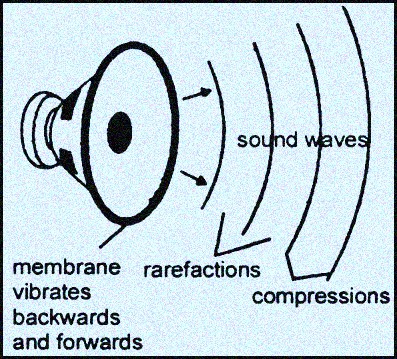Definition of sound – A sound is a form of energy, produced when air molecules vibrate in a pattern called waves. Hence, the sound is a wave.
● Vibration can be described as a back-and-forth motion of an object.
● Depending upon the vibrations, a sound is produced. Sound cannot be produced without any vibration.

How do humans produce sound?
- Human beings have a voice box or larynx which is present in their throat on the upper side of the windpipe.
- The larynx has two vocal cords with a narrow slit between them so air can pass through it.
- As the lungs throw the air out of the windpipe, it passes through the slit and hence allows the production of sound as the vocal cords start vibrating.
- The vocal cord muscles also play a role in the production of sound.
- Their thickness and tightness describe the quality or type of voice a person has.
- The vocal cords in males are of length 20 mm and females have 15mm long vocal cords. Children, on the other hand, have very short-length vocal cords. Hence, the voices, their quality, and their type are always different in women, men, and children.
How do sound waves propagate through a medium?
● Sound always requires a medium to travel from the source of its production to the receiver end. Different mediums of propagation of sound are air, liquid, and solids.
● Sound cannot travel through a vacuum as it lacks any medium of transmission.

How sound travels in a medium?
● Sound needs some vibration of molecules to travel.
● Solids, liquids, and gases all have molecules present in them which allow the propagation of sound.
● These molecules or particles in solids, liquids, and gases are packed in varied ways.
● Solids have tightly packed particles in them and hence they allow fast propagation of sound through them as the vibrations can be carried easily from one particle to another.
● Liquids have slightly loosely packed particles and hence it takes a little time for sound to travel in water or through a liquid.
● Gases have completely loosely packed particles and hence sound takes the most time in travelling through the air.
How do humans hear the sound? Working principle of The Human Ear.
● We know that sounds are produced as waves in the air or any other medium.
● As these sound waves travel to our ears they convert them into electrical signals or messages that our brain can understand.
● Our ears have a special structure that allows this function.
● There are three major parts of the human ear:

- The outer ear (Pinna): It catches the sound waves and forwards them to the next part of the ear, that is, the middle ear.
- The middle ear: It converts the sound waves into vibrations that then travel to the inner ear. It can do this with the help of the eardrum. The eardrum is a thin rubber-like sheet present in the Middle ear. As the sound waves reach the eardrum, it vibrates and these vibrations propagate to the inner ear.
- The inner ear (cochlea): It receives the vibrations sent by the eardrum. It contains a liquid substance and the vibrations that enter the inner ear moves through this liquid. There are tiny hairs present inside the inner ear that turn these vibrations into signals for the brain and pass them to the brain through the hearing nerve. As the brain receives the signal it interprets the sound. However, this whole process is so quick that we cannot notice it.